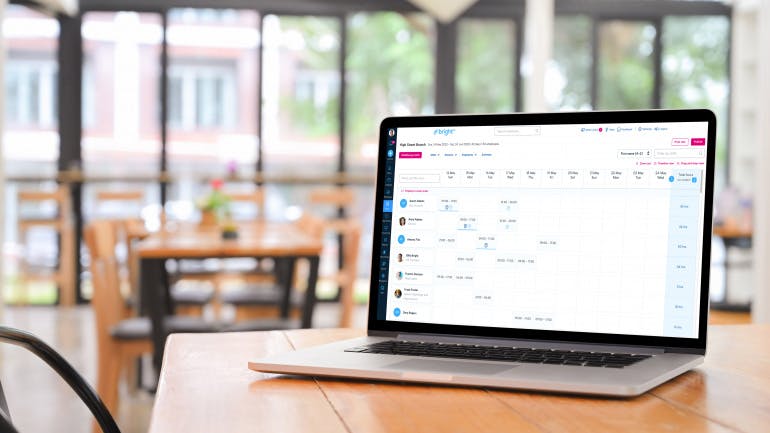First published on Thursday, June 4, 2020
Last updated on Friday, November 22, 2024
Running a business that operates through the night isn’t easy. And managing night shifts comes with its own set of challenges. From maintaining employee wellbeing to ensuring productivity and compliance, there’s a lot to think about.
But with the right approach, you can create a smooth-running operation and a supportive environment that helps your night workers thrive.
Here’s how you can manage night shifts effectively and keep your team happy and healthy.
Know your legal responsibilities for night shifts
First things first, you need to know the legal requirements around night shift work. The UK government defines night shift working, as staff who regularly work at least three hours between 11 pm and 6 am.
However, if you want to adjust this timeframe, you can agree on a different 7-hour window with your employees, but it must include midnight to 5 am.
Employees who work night shifts shouldn’t work more than an average of 8 hours in a 24-hour period, including any overtime. This average is usually calculated over a 17-week period.
You must also offer health assessments to night workers before they start and regularly after that. It’s important to check in on their wellbeing and spot any issues early on.
Following these rules isn’t just about staying compliant—it’s about looking after your team.
Plan your night shifts carefully
A well-thought-out schedule is the foundation of successful night shift management. Fairness and flexibility are key. So, if possible, give your team options when it comes to their night shift work.
Some options you can consider are:
Shift rotation
Shift swapping
Compressed work weeks
For more examples of the different types of shift patterns you can try, see shift patterns at work.
Prioritise health and safety
The night shift can bring unique risks, so safety should always come first. Start by conducting a thorough risk assessment for your night-time operations. Identify any hazards specific to working at night—such as fatigue, reduced visibility, or lone working—and put measures in place to address them.
Here’s where health and safety software can help. It lets you track incidents, flag patterns, and ensure compliance with regulations. Plus, it provides lone worker protections, like check-ins and emergency alerts, which are vital when fewer staff are on-site.
Support employee wellbeing
Night shifts can take a toll on mental and physical health. Employers who prioritise wellbeing are more likely to retain happy, healthy workers.
Here’s some things you can do to support your team:
Provide tips on sleep hygiene, like maintaining a consistent sleep schedule and creating a dark, quiet environment for rest.
If you provide food during shifts, prioritise nutritious snacks to keep energy levels stable.
Schedule wellbeing check-ins to ensure employees are coping with the demands of night work.
A little effort here can go a long way in reducing fatigue and keeping your team engaged.
Create a positive work environment
Night shifts can feel isolating, especially when most of the business is off during those hours. Creating a supportive environment can make a big difference. So, make it a habit to check in with your night shift staff.
Even a quick chat can help them feel valued and give you insights into any issues they might be facing.
It’s also important to make sure your night workers have access to the same facilities as daytime staff. This means break rooms, kitchen amenities, and anything else they need to do their job comfortably.
Provide the right training and support
Employees who work night shifts face unique situations, so tailored training is essential.
Thank about cover topics like:
Fatigue management
Lone working protocols
Emergency procedures
Providing access to training materials and resources, either online or through your HR systems, ensures your team has what they need to handle challenges confidently.
It’s also best practice to ensure they know where to find support if they need it—whether it’s contacting a manager or using an employee assistance programme (EAP).
Don’t forget about ongoing training. Offering training sessions during night hours helps them feel included and keeps their skills up to date.
Manage workloads and breaks effectively
Keeping an eye on workloads is key to preventing burnout and maintaining productivity. That’s why it’s important to monitor and regularly check that the workload for night shifts is manageable.
Also, short breaks can help night workers stay alert and reduce fatigue. In fact, research shows that 10-minute ‘micro-breaks’ may help prevent worker burnout. So, encourage regular breaks and make sure they take them.
If you need help spotting signs of overworking, you can use scheduling software or a clock in app to track shifts, breaks, and workloads.
Recognise and reward your night workers
Night workers often feel overlooked compared to their daytime colleagues. Showing your appreciation can go a long way.
Offering additional pay for night shifts (also known as a night shift premium) is a great way to acknowledge the inconvenience of working unsociable hours. You could also set up an employee recognition programme specifically for night shift employees.
And don’t forget to take time to celebrate milestones and achievements. Even a small gesture can make your night workers feel valued and appreciated.
Monitor performance and adapt
Managing night shifts isn’t a one-and-done task. Regularly review your processes to see what’s working and what could improve.
Check in with supervisors and team members for feedback
Analyse data, such as absenteeism rates or safety incidents, to spot trends
Stay up to date with regulations and industry standards to ensure compliance
Being proactive and open to change will help you keep your night shift operations running smoothly.
Get help managing night shifts with BrightHR
Managing night shifts effectively isn’t just about scheduling— it’s about supporting your team, prioritising safety, and creating a workplace where employees feel valued. With the right approach, you can turn night shifts into a productive and positive part of your business.
Start by listening to your team, using technology—like BrightHR— to streamline processes, and making employee wellbeing a top priority. When you invest in your night shift workers, they’ll repay you with loyalty, performance, and peace of mind that the job’s getting done, no matter the hour.
Interested in getting started with BrightHR’s software solutions for managing night shifts? Book a free demo today.
Our HR solutions not only make scheduling night shifts a breeze but with health and safety software, employment law advice and 24/7 health & safety support services, you and your team get the support and resources you need—anytime, anywhere.
Have a question?
Ask away, we’ve got lightning fast answers for UK business owners and employers powered by qualified experts.










